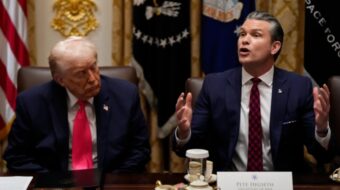
Much of the world is facing a crisis around the use and abuse of various sorts of substances. Headlines around the world show many deaths each day due to overdoses. In the U.S., approaches to this issue have typically involved prohibition, enforcement, and corrections. Other jurisdictions such as the Netherlands and Portugal have successfully tried legalization and drug therapies for users. A new six-part documentary series debuted July 14 on Netflix, entitled The Business of Drugs.
The series is directed by Erik Osterholm, Jesse Sweet, Nick Carew, and Eric Strauss, hosted by Amarylis Fox. It features a former CIA analyst who explores issues around six different types of illegal drugs. For leftist critics of drug prohibition, this series provides excellent examples of how capitalism is a major cause of the drug crisis—both in terms of why many people use drugs in the first place, and in terms of the fact that the U.S., in particular, currently lacks a planned or coherent response to this crisis. In what may be a surprise to many, the CIA analyst herself ends the series with a clear critique of “unregulated capitalism.” Perhaps the most politically salient episodes are the ones which address cannabis and opiates.
Across Canada, and in parts of the U.S., possession of cannabis for personal use has recently become legal or decriminalized to some extent. What currently exists in the U.S. is legalization or prohibition applied on a jigsaw puzzle of state law, with no coherent national strategy around legality or approach. In the U.S., unlike countries such as Canada, individual states write criminal law in terms of their own territorial jurisdiction. At the same time, the federal government also maintains laws applying to interstate trade and international borders. This makes an almost impossible patchwork, which can create real problems for those wishing to earn a legitimate living on growing and distributing legal cannabis.
Despite the fact that cannabis has become legal in some state jurisdictions, many people are still serving life sentences in penitentiaries on federal drug charges, particularly if their charges involve interstate or international distribution. This reality is often played out along racial and class lines. While drug prohibition, arrests, and prosecution have often been more targeted toward Black and brown people, large corporations are the ones who have, predominantly, benefited the most from investments in legal cannabis production and distribution. The irony shown is that mostly Black and brown faces serve custodial sentences while corporations earn profits selling the exact same substance. The series covers this point well and is to be lauded for asking the difficult questions about the intersection of race and class when it comes to drugs.
The episode on cannabis showed how it is major corporations that are gaining the most from legalization. In California, for example, in order to be licensed to start a legal cannabis operation, one has to show $1 million in assets as a minimum. In addition, one needs local and state license fees. As cannabis is still federally illegal, it is almost impossible to find a bank or credit provider to loan money, or even to establish an above-board bank account. Though billions of dollars are earned by the large corporations growing cannabis, the small producer is essentially priced and regulated out of the legitimate market. The positive side to legalization has been a significant renewal of employment in the cannabis sector, even in small conservative towns throughout California. The series does illustrate the story of one outlier, a Black couple who are trying to change the face of legal cannabis to include a more diverse presence.
The episode about opiate use and abuse is clearly an anti-capitalist cautionary tale. The documentary places the blame for the modern opiate epidemic on the doorstep of “Big Pharma” corporations such as Purdue, who marketed OxyContin, beginning in 1996. One opiate user remarked, “the best drug dealer I’ve ever had was my pharmacist.” Predominant North American culture seems to have a notion of drug users as people using dirty needles in the street. We don’t often see a depiction of wealthy professionals presenting a legal prescription to their neighborhood pharmacy!
Since 1996, this drug has earned billions of dollars of profit for Purdue. The death toll engendered by OxyContin was shown to have directly come from corporate greed. Multiple lawsuits have established that the drug was promoted as a response to a need to address chronic physical pain without also being addictive. The corporation clearly underplayed the addictive nature of the drug they produced—despite its own data that established its nefarious nature. Pharmaceutical sales representatives were hired based on backgrounds in sales, not in science. They were given bonuses based on convincing doctors to prescribe the medication. Reps would tell physicians that patients showing a desire for higher dosages were responding to “pseudo-addiction” and not the hallmarks of traditionally-understood behavior.
The documentary also showed that many patients, over time, routinely required more pills to meet their growing addiction. In fact, many came to realize that street-sourced heroin was much cheaper than their Oxy prescription. Many who were paying hundreds of dollars per day to buy OxyContin came to realize that an equivalent of heroin would cost around one-third that amount. In terms of the effects on the body, the drug is almost indistinguishable from heroin. Oxy also meant that a transition took place which meant otherwise law-abiding middle-class people were making the transition to illegal substance use.
The series is very powerful. It explores the drug crisis in important ways. It features an intelligent critique of what happens when a public health crisis is affected by the problems inherent in capitalism itself. In the series, the “War on Drugs” is shown to be an utter disaster on many levels. Prohibition is clearly based on a moralistic framework that seems to hold that drug use is immoral and that users are bad people. Punitive approaches are also shown as ineffective in stopping drug use. The series also looks at those who illegally deal drugs in more humane, and less judgmental ways.
While the series criticizes “unregulated capitalism,” it also provides evidence that capitalism itself has inherent flaws which make the drug crisis much worse. Regulation of corporate entities does not mean that the profit motive goes away. Unfortunately, we may envisage another “Purdue” without a serious overhaul of the current regime of regulation. Additionally, by stigmatizing users, racism and other forms of oppression play out in the selective application of criminal sanctions. Perhaps future series could explore alcohol and tobacco, which produce much more damage, in terms of health and lives lost as compared to illegal substances.










